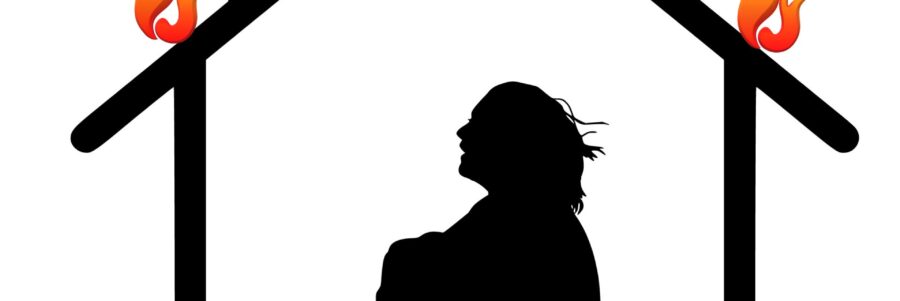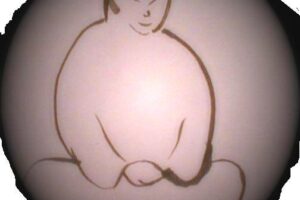
While dictating this Dharma Byte, I was uncertain how to appropriately name it, but the reasons for settling on high anxiety should become clear in what follows. This is one of the most common issues faced by people today, that of a generalized anxiety, with its cast of many supporting characters and imperatives for action, which can manifest in a broad range from mild disorientation to what the experts call panic attack. Any one who will not admit to being subject to anxiety from time to time, from the terrible two-year-old to the most adept Zen practitioner, either isn’t paying attention or is being disingenuous.
Youthful anxiety and that of those of advanced years share one element in common: a perceived, and actual, lack of control. Underlying is the fact that people don’t know the factors most directly effecting their existence with any degree of surety, and instead of confronting this reality directly, spend entire lifetimes evading and distracting their attention from it. The don’t know mind of Zen springs from this truth as well.
Matsuoka Roshi likened our typical response to being like a rat in a burning house, running to escape the flames, coming up against another wall of flames, and running back the other way until, finally, it is trapped in the corner of the room, flames closing in all around. What does the rat do?
zenkai taiun michael elliston, roshi
A Zen monk named Seikan Hasegawa wrote a book titled The Cave of Poison Grass many years ago, in which he urged the reader to confront the great matter of Zen early in life rather than late, not to wait until on the deathbed, as that would be like “trying to eat soup with a fork.” It is unfortunate that many in my generation have still not begun to confront the grave matter of life and death, and are running out of time, let alone the energy and strength they once enjoyed. I feel very fortunate to have been exposed to Zen in my mid-twenties, and to be able to sit comfortably in the cross-legged posture at my age, which some long-term practitioners and older Zen teachers are unable to continue.
Part of the inspiration for this dissertation stems from a dream with a recurring theme, which I suspect may be somewhat familiar, if different in terms of imagery, to some readers. I am at an airport, experiencing differing degrees of difficulty locating my departure gate, keeping track of my baggage, losing things or not being sure I have what I need, asking people where to go, and so on.
In this case it was outdoors, slogging fluidly but with difficulty through knee-deep sand as in a desert, with a covering layer of brilliant red sand. Hyper-real, almost lucid dreaming, a high degree of anxiety as the predominant emotion permeating the setting and action of the dream. I interpret this as reflecting the stress-inducing conditions of everyday life, such as physical health, economics, difficulties of finishing projects with so many interruptions, et cetera, symbolized herein; but also the longer-term life-and-death situation we find ourselves facing, which Buddha analogized as a burning house.
Matsuoka Roshi likened our typical response to being like a rat in a burning house, running to escape the flames, coming up against another wall of flames, and running back the other way until, finally, it is trapped in the corner of the room, flames closing in all around. What does the rat do?, he would ask. But he would not give an answer.
An actual burning house, of course, would be the cause of a very high-stress reaction, the instant one becomes aware that the house is indeed irretrievably on fire. Later in life, people naturally become more aware of impending death—the burning, burning, burning.
This kind of anticipation, that comes naturally with age, is not necessarily a form of wisdom, but at least represents a change from the attitudes of youth or adolescence, where scientists who study such things have said that the part of the brain that is hard-wired to be aware of danger to one’s life and limb is not yet complete. Thus we read of boys as well as girls in their middle teens “auto-surfing”: riding on the tops and other outside surfaces of vehicles driven at full speed, often ending in the unintended consequence of the surfers’ violent death. While this may seem downright stupid, and may be partially fueled by alcohol and other intoxicants, it is no more stupid or ignorant than to live life avoiding the full awareness of death. Some old teacher said to “stamp life and death on your forehead, and never let it be out of your mind.”
This attitude may seem a morbid preoccupation, but it is nothing but rational engagement with the reality of mortal life. Life, after all, to a great extent, takes its meaning from death, just as death takes its meaning from life. In Buddhism and Zen in particular, this embrace of the dual dance of life and death is a traditional philosophical position, held by all great Zen Ancestors who bothered to talk about it.
The attitude of Zen masters concerning the prospect of death ranges from nonchalance to irreverence, especially toward the conventional taboos and memes associated with it. For example, Hui-neng the sixth patriarch in China, instructed his followers after taking food and announcing “Please sit down, for I am going to say good-bye” (The Diamond Sutra & The Sutra of Hui-neng; Price & Wong; Shambala Dragon Editions p. 151-153):
Take good care of yourselves. After my passing away, do not follow the worldly tradition and cry or lament. Neither should messages of condolence be accepted, nor mourning be worn. These things are contrary to the orthodox teaching, and he who does them is not my disciple. What you should do is to know your own mind and realize your own buddha-nature, which neither rests nor moves, neither becomes nor ceases to be, neither comes nor goes, neither affirms nor denies, neither stays nor departs. Lest your mind should be under delusion and thus fail to catch my meaning, I repeat this to you to enable you to realize your essence of mind. After my death if you carry out my instructions and practice them accordingly, my being away from you will make no difference. On the other hand, if you go against my teaching, no benefit would be obtained, even if I continued t stay here.
This is not a morbid fascination with death, but simply a recognition of its inevitability. This fact of life is part of the imperative to awaken in Buddhist practice, and sets the tone for a sense of urgency: that is, that we don’t have time to waste. The last phrase in the venerable Harmony of Sameness and Difference (Sandokai; Sekito Kisen 800 a.d.) is:
I respectfully urge you who study the mystery: do not pass your days and nights in vain.
This recalls a passage from the Bible, book of Ecclesiastes 1:2, “Vanity of vanities, saith the Preacher, vanity of vanities; all is vanity.” Selections from the Bible including this and the Book of Job were part of an innovative curriculum in English literature, to which I had the good fortune to be exposed in my senior year in high school. Without citing further examples, suffice it to say that the vanity and futility of most of our activities in daily life is widely recognized by most philosophies and religions.
So, what to do? How to change our behavior to come into harmony with this truth? Or if impossible to alter behavior, given the responsibilities that we face as householders and lay people—to family, colleagues at work; as human beings to the greater community; and as the so-called stewards of the planet, to all sentient beings—perhaps at least our understanding and resultant view can at least change.
Then of course there are the exigencies, or unexpected consequences of life. Like the life of a fruit fly, which can be short and sweet, especially when you trap them in a bowl filled with decaying fruit and juice. Some drown, some don’t. The latter are released into the great outdoors. Those that die presumably die happy, at least.
On the news there was a story of an unintended consequence of attending a large rally celebrating the victory of the local professional team in the final playoffs of the season. The place suddenly collapsed under the weight of all the happy people celebrating.
So along with the inevitability of death from aging or sickness, there is also the impending possibility or even a probability of death from unexpected sources, sometimes as the unintended consequence of our own acts of commission or omission, which only adds to the urgency and anxiety. Most everything is out of our control, even the effects of our own behavior and choices.
So it is entirely reasonable that one would suffer dreams characterized by high anxiety. To ignore this anxiety and its true source in daily life would be the height of foolishness. So I am happy and grateful to my dreams for this reminder, which keeps me on my toes, or at least impels my return to the cushion.
Zen’s recommended strategy for dealing with anxiety occasioned by the unpredictable nature of this existence, which Buddhism characterizes as of the nature of suffering (Skt. dukkha), is simply zazen. Since there is no such existence possible absent the price of suffering, without becoming despondent over this fact, or looking to the next life or afterlife as an escape from it, Zen practitioners face it squarely, as coming with the territory, most directly confronted on the cushion. In this context, the promise of paradise or consignment to the flames of hell come off, respectively, as a consolation prize for the indignities inflicted upon the living, and as adding future insult to present injury.
The belief in the self or soul, characteristic of many religions and philosophies, may inadvertently foster aberrant behavior such as suicide bombings, in hopes of a reward in heaven, 72 nubile females or raisins, take your pick. Somewhat justifiable underpinnings of political or practical concerns in bringing jihad to unjust situations nonetheless do not rationalize the futility of propping up one’s hope on the existence of a soul. The invention of the soul is perfectly understandable, but nonetheless an invention of the imagination.
Belief in the soul may be yet another case of self-deception and evasive maneuvering.
The existence of an eternal soul would amount to a “true chariot” existing amongst the disassembled parts of the chariot of Buddha’s analogy to the Five Aggregates (Skt. skandhas). A better metaphor may be other living creatures, such as jellyfish, which seem to exist and function as one organism, but are actually a pastiche of many creatures.
In confronting the issue of the inevitability of death, Master Dogen unhesitatingly promotes the most effective, “excellent method” (Jijuyu Zammai) to confront our own ignorance regarding these matters. Zen mediation (zazen) begins the process of seeing the delusive nature of this so-called self, all the way through to the emptiness at the heart of the aggregates of clinging, as mentioned early on in the Heart Wisdom chant.
He also touches on the futility of depending upon certain other practices as viable substitutions for zazen. For example the “tiptoes of walking” is criticized (Fukanzazengi) as being essentially dysfunctional, pursuing enlightenment elsewhere other than where one finds oneself in this present moment. He further warns against the contradictory nature inherent in certain attitudes while pursuing zazen itself, such as believing that realization is somehow dependent upon practice and enlightenment, rather than being a return to the awareness of ever-present reality of buddha-mind.
In my dreams, the pursuit of the connecting gate for the next leg of my flight may be analogous to the futility of traveling to foreign lands, hoping to discover enlightenment there. The fact that Master Dogen had himself traveled a long and perilous journey to China, where he had his first profound insight, was clearly coincidental in his own mind. He maintained profound gratitude for his Chinese teacher, Nyojo, for the rest of his life, and the fact of his awakening under Nyojo’s supervision is clearly at least partially dependent upon the understanding and view, or right wisdom, of Nyojo himself. But the momentous event must be attributed in larger measure to the intent, sincerity, and sense of urgency of the young Master Dogen himself. This point cannot be overstated.
Young people in their mid-twenties and beyond today, when pursuing the practice of Zen should strive to develop and sustain this kind of intensity and sense of urgency. It should be coupled with respect for the teaching, and ideally, for the proximate teacher representing Zen, though the present culture of the individual lobbies against this idea.
In order that the pursuit of insight not be rendered futile by misconceptions and inappropriate attitudes, which after all only get in our own way, the student should practice flexibility of mind to trust and imitate the teacher, at least in the beginning.
No actual dependency upon the teacher is implied here. It is the student’s life, and the student’s practice. For this reason it must be said that if one encounters problems in Zen practice, the last resort should be to blame the teacher. Instead, sincere students should check out other teachers to gain some perspective, and honestly examine the depth and breadth of their own practice. And further, any unexamined societal attitudes that they may be harboring, and that may be getting in the way. Zen is not antisocial, but asocial.
The list of possible misunderstandings is too long to cover book length, and even then, grows variations with each generation. Especially difficult to avoid seem to be new excuses for blaming someone else for failings in practice. Studying the ancient masters such as Buddha, Master Dogen, and Matsuoka Roshi, you can make up your own list, and add it to the 108 delusions for a start.
The Zen way, however, is to cast off the ancient and endless blame game, in favor of committing wholeheartedly to zazen practice. Confronting the roots of anxiety directly, without recourse to rationalization, constitutes the Zen way. For any and all difficulties in existence, such as (fill in the blank), the same excellent method is recommended.
We might usefully speak of two fundamental applications or aspirations of practice, one being as a method of dealing with various problems, or koans, as they arise on a daily basis—often multiple times in different guises every day. The other being the possibility of transcendent insight suddenly or gradually arising. As if the yen yang of existence itself consists of vacillation between the ideal and the everyday. Ideally, all would have profound insight, which, ideally, would relieve anxiety. Practically speaking, another condition is going to come along soon, like the leaves dodging the rake in the wind, to which the reaction of the monkey mind, geared to survival, will be, once again, anxiety.
So let’s get used to it. Returning to the cushion, thoroughly examining the anxiety itself, disassociating its cause from the particular circumstances of the present irritant. The general principle of anxiety-reaction can thus be extracted from the many particular cases, to paraphrase R. Buckminster Fuller’s definition of human intelligence. And we may find that it has little or nothing to do with the specifics of the moment. It is instead the natural reaction of the sentient being to the vagaries of existence itself.
Imagine what it must be like to be a squirrel. Or a bird. Or a lizard, even an earthworm. You don’t have to imagine that their life consists of an extremely high level of anxiety. You can see it in the twitching of the squirrel’s tail and alert jerking of the head, checking all avenues of possible attack; you can hear it in the chatter and sudden swoosh of the flock taking flight simultaneously as they sense danger; and in the agonized twisting and flipping of the worm when touched, removed from the comforting confines of the soil.
Assuming that this same hyperactive alertness is hardwired into humans’ lizard brain, the stem hidden deeply under the covering folds of the inner and outer cortices. It is natural that it works its way to the surface from time to time, and thus invades conscious. It may be surprising to the meditator who uncovers this level of anxiety lurking in the depths of the mind, awakened from its usual complacency lulled by the various sedatives, both chemical and otherwise, ingested to keep it at bay.
Anxiety manifests as “butterflies” felt when going onstage to perform in a play or to give a public talk. With enough time and experience, it can be sublimated, not suppressed, providing the energy necessary to drive the performance. Professional actors and public performers of all stripes have mastered this accepting attitude and technique. It is part of the attraction of the performing arts, and can even become addictive, a rush of adrenaline.
In a similar way, rather than trying to divest ourselves of anxiety, it seems more realistic, and wiser, to allow it to sublimate, or be assimilated into, the energy force (J. ki) driving our life. To wish otherwise, to hope for an anxiety-free existence, seems contradictory to the teachings of Buddhism as well as to the evidence of our senses. Just as we “jump in, both feet” when it comes to physical resistance and pain in meditation, we do the same for the mental and emotional discomfort we define as anxiety. Embracing the dis-ease can be the simplest way to ease it.
This may sound unwise in the context of a culture that coerces its members into feeling that the least discomfort on any level—physical, mental or emotional—is to be avoided at all costs. But it is the beginning of wisdom, according to Zen Buddhism.
The first two points of the Eightfold Path—right view and right thought or understanding—together are said to comprise right wisdom. Through diligent practice of the eighth point, usually mentioned last—right meditation—Zen proposes that our own view and thought will evolve to approach those of Buddhism, or that of Buddha himself. This then comprises the evolution of wisdom, the only true wisdom that is available in this existence.









